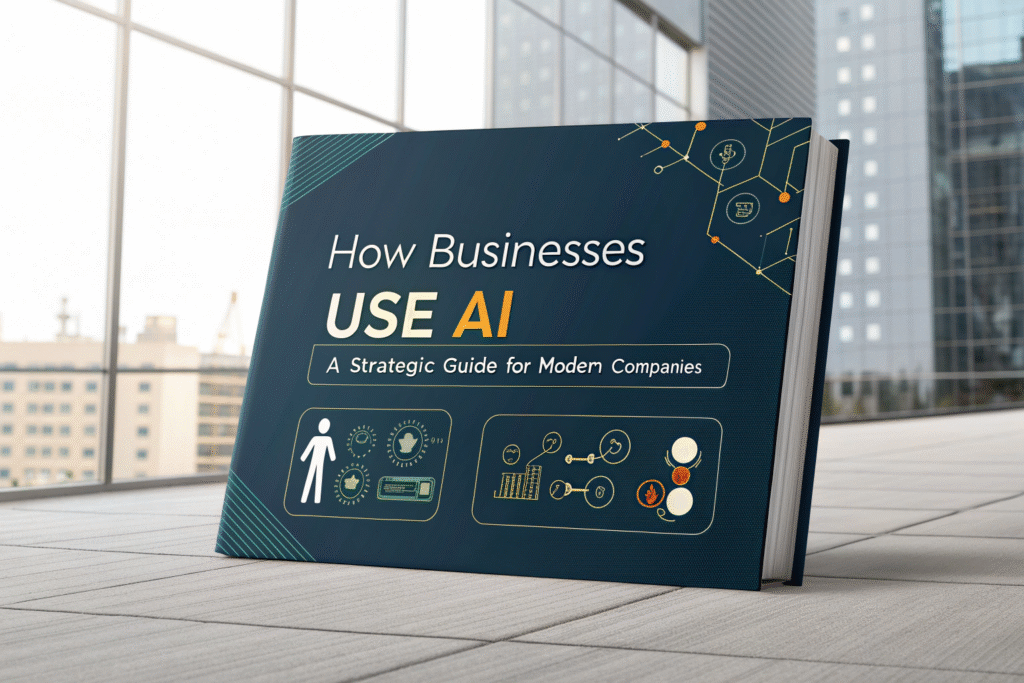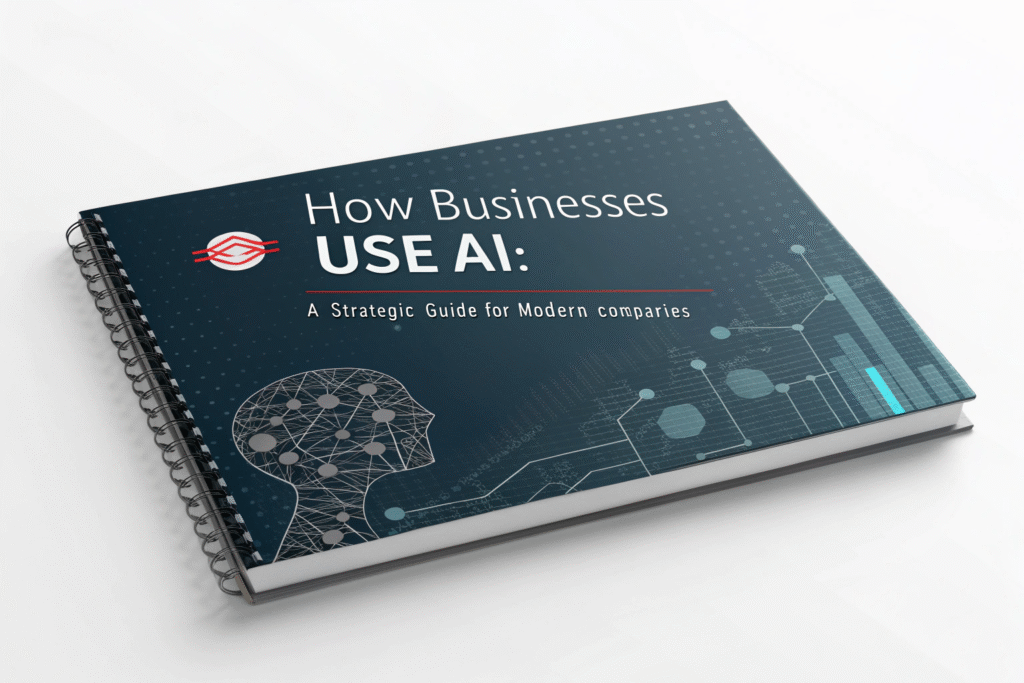
Introduction
Artificial Intelligence has transitioned from science fiction to a core business asset. Today, understanding how businesses use AI is crucial for maintaining a competitive edge. From automating routine tasks to generating groundbreaking insights, AI is reshaping entire industries. Consequently, companies that leverage these tools are seeing significant gains in efficiency, customer satisfaction, and innovation. This guide will explore the practical ways businesses use AI to drive growth, providing a clear roadmap for entrepreneurs and leaders ready to embrace this transformation.
A Brief History & Evolution of Business AI
The journey of AI in the corporate world has been one of rapid acceleration from concept to cornerstone.
- The 1980s-1990s: Expert Systems. Early business AI took the form of rule-based “expert systems.” These systems were designed to mimic human decision-making within a very narrow field, such as diagnosing machine issues or approving loans. However, they were often expensive and inflexible. As a result, businesses struggled to scale them effectively, and many eventually sought more adaptable AI solutions.
- The 2000s: The Data Revolution. The rise of the internet and digital operations generated unprecedented amounts of data. Machine Learning algorithms began to shine, enabling tasks like fraud detection in finance and basic recommendation engines in e-commerce.
- The 2010s-2020s: Mainstream Adoption. Cloud computing made powerful AI tools accessible and affordable for businesses of all sizes. AI became integrated into everyday software like CRM systems (e.g., Salesforce Einstein) and marketing platforms.
- Present Day: The Generative AI Boom. The advent of generative AI models like GPT-4 has democratized content creation and complex problem-solving, opening up new frontiers for how businesses use AI in creative and operational roles.
Who is Adopting AI? Audience & Demographics
AI adoption is no longer limited to tech giants. Its use now spans company size and sector:
- Large Enterprises: Use AI for large-scale optimization—managing global supply chains, developing new drugs, and conducting mass personalization in marketing campaigns.
- Small and Medium-Sized Businesses (SMBs): Leverage AI to compete with larger players, using it for tasks like chatbots for customer service, content creation for marketing, and data analysis to inform strategy.
- Startups: Often build their entire business model around AI, creating innovative products and services that disrupt established markets.
- Across Departments: Adoption is functional. Marketing, sales, HR, finance, and operations teams are all finding unique applications for AI tools.
Key Features & Functions of Business AI
Modern AI offers a diverse toolkit. Here are its core capabilities:
- Process Automation (RPA):
AI bots can automate repetitive, rule-based digital tasks — such as data entry, invoice processing, and report generation — with high accuracy and speed. As a result, businesses can save time, reduce human error, and allow employees to focus on higher-value activities. - Predictive Analytics:
By analyzing historical data, AI can forecast future outcomes — such as sales trends, customer churn likelihood, and machine maintenance needs. Furthermore, these predictions enable businesses to plan ahead, optimize resources, and minimize risks. In addition, teams can make data-driven decisions more confidently, which improves overall performance. - Natural Language Processing (NLP): This allows machines to understand human language. Applications include sentiment analysis of customer feedback, intelligent chatbots, and summarizing long documents.
- Computer Vision: AI can interpret and analyze visual information. This is used for quality control in manufacturing, analyzing medical images, and enabling self-checkout in retail.
- Generative AI: This function creates new content—from writing product descriptions and email campaigns to generating code and designing marketing assets.
The Business Potential: Transforming Core Functions
The ways businesses use AI are transforming fundamental operations:
- Marketing and Sales: AI personalizes customer journeys by recommending products, optimizing email send times, and even scoring leads based on their engagement. For instance, sales teams use AI-powered platforms to get insights before client calls.
- Customer Service: AI-powered chatbots and virtual assistants handle routine inquiries 24/7, freeing human agents for complex issues. Furthermore, AI can analyze support tickets to identify common pain points.
- Operations and Supply Chain: AI optimizes inventory levels, predicts demand fluctuations, and finds the most efficient delivery routes. In manufacturing, it enables predictive maintenance, preventing costly downtime.
- Human Resources: From screening resumes to identify top candidates to analyzing employee feedback to improve retention, AI is making HR processes more efficient and data-driven.
- Product Development: AI can analyze market data and customer feedback to suggest new product features or even help engineers simulate and test designs virtually.
Best Practices & Tips for Implementation
Successfully integrating AI requires a strategic approach. Follow these best practices:
- Identify a Clear Business Problem: Start with a specific, high-impact challenge, such as “reduce customer support response time” or “improve forecast accuracy.” Avoid implementing AI for its own sake.
- Ensure Data Quality and Accessibility: AI models are fueled by data. Therefore, you need clean, well-organized, and accessible data to train effective AI systems.
- Focus on Augmentation, Not Replacement: The most successful strategies use AI to augment human workers. Use AI to handle repetitive tasks, allowing your team to focus on strategic thinking, creativity, and complex problem-solving.
- Start Small and Scale: Begin with a pilot project in one department. Use the lessons learned to build momentum and gradually expand AI adoption across the organization.
- Prioritize Ethics and Transparency: Be mindful of data privacy, algorithmic bias, and transparency. Ensure your use of AI is ethical and that you communicate clearly with customers and employees about how it is being used.
Challenges & Limitations to Consider
While powerful, AI comes with challenges that businesses must navigate:
- Data Privacy and Security: Handling large datasets responsibly is critical to maintaining customer trust and complying with regulations like GDPR.
- Integration with Legacy Systems: Incorporating AI into older, existing IT infrastructure can be technically complex and costly.
- Skill Gap: There is a high demand for talent skilled in data science and AI implementation, making it difficult for some companies to build internal expertise.
- Cost and ROI Uncertainty: Initial investment in AI technology and expertise can be significant, and calculating the return on investment can be challenging for new projects.
- Bias and Fairness: If trained on biased data, AI systems can perpetuate and even amplify those biases, leading to unfair outcomes in areas like hiring or lending.
The Future Outlook of Business AI
The evolution of AI in business is poised to accelerate further:
- Hyper-Automation: The combination of AI with other technologies like Robotic Process Automation (RPA) will lead to end-to-end automation of complex business processes.
- AI-Native Organizations: Companies will be built from the ground up with AI integrated into every product, service, and operational decision.
- Responsible AI: As AI becomes more pervasive, frameworks for ethical AI, including audit trails and explainable AI (XAI), will become standard practice.
- Generative AI for Strategy: Beyond content creation, generative models will be used to simulate business scenarios, model market reactions, and assist in high-level strategic planning.

Conclusion
The question is no longer if but how businesses use AI to thrive in a competitive landscape. From automating routine operations to unlocking deep customer insights, AI offers a pathway to unprecedented efficiency and innovation. However, successful implementation hinges on a clear strategy, a focus on human-AI collaboration, and a commitment to ethical principles. By thoughtfully integrating AI, businesses can not only optimize their current operations but also reinvent their future possibilities. The time to start exploring is now.